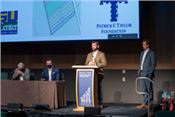Louisiana Farmers Represent U.S. Cotton At Global Conference

Mead and Marshall Hardwick present during the Sustainable Cotton Roundtable Event in Dublin, Ireland.
REXANNA POWERS
BATON ROUGE, LOUISIANA
Tensas Parish cotton farmers Mead and Marshall Hardwick of Hardwick Planting Company represented the U.S. cotton industry at the Textile Sustainability Conference held Dublin, Ireland late last year.
The conference centered around the fiber industry and serves as the Textile Exchange’s annual global conference.
Over the course of five days, representatives of the cotton, fiber, and textiles industry from across the world came together to discuss cohesive sustainability strategies that will not only improve business but the planet. The Hardwicks were the only farming family present representing the agriculture.
“Our involvement with the U.S. Cotton Trust Protocol got a foot in the door for us to talk about sustainability throughout the cotton sector,” Mead Hardwick said. “The farmer perspective is not typically heard at high level conferences like this so we thought it would be a good opportunity to speak and present about what is going on with the Patrick F. Taylor Foundation project with regard to the best management practices and our efforts as farmers in Louisiana to improve sustainability.”
The Hardwicks’ farm is part of the LSU AgCenter’s Patrick F. Taylor Foundation project, which aims to develop environmentally efficient and economical best management practices in agriculture.
The brothers fielded questions about cotton production and the sustainability of conventionally grown to an audience of diverse perspectives. More than 750 companies and brands, like Target, were represented at the conference and hailed from 45 countries across the globe.
“It is important to understand the demands for cotton so that the U.S. cotton industry can remain a reliable source for sustainable goods,” he said. “There is a lot of uncertainty among brands and retailers about what sustainability is, so we were happy to provide a fresh perspective that shed light on the farmers who produce the textiles that are being sourced.”
Hardwick said their presentation prompted questions about farming cotton from conference participants.
“They never have the opportunity to talk to a farmer and ask basic questions about how production actually works, what we do to ensure high quality cotton, and the work that it takes to maintain a cotton operation – people were fascinated by the logistics and had no idea that it took so much to grow cotton.”
The Hardwicks’ participation in the conference gave international exposure to the Patrick F. Taylor project. The brothers also came away with information that will benefit their farm.
“Understanding the textile industry’s demand for sustainable goods allows us the opportunity to fine-tune our production goals,” Marshall said. “Opening up that dialogue with brands to have conversations with farmers and the agriculture industry is the first of many steps to bridge the gaps between what is demanded and what is practical for production.” ∆
REXANNA POWERS: LSU AgCenter